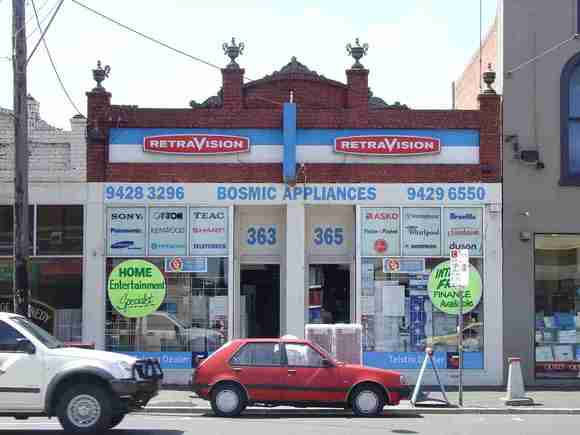| Back to search results » | Back to search page » |
|
363-365 Bridge Road
Other NameShop & Residence Location363-365 Bridge Road, RICHMOND VIC 3121 - Property No 193735 LevelIncl in HO area contributory |
|
Statement of Significance
Precinct statement of significance Component streets include: Bridge Road, Church Street Waltham Street, Statement of Significance What is significant? Created as a major road reserve in Robert Hoddle's Crown Allotment survey of the 1830s (18), Bridge Road was connected to Hawthorn by a bridge over the Yarra River in 1855. The eastern end of Bridge Road was known as Campbell Parade after it was widened in the 1870s. As a main thoroughfare from Melbourne to the eastern suburbs by the mid 1850s, retail and service trades concentrated at the west end of Bridge Road, including butchers, drapers, a shoemaker, fruiterers, tailors, hairdressers, grocers, Egan's steam sawmill and several hotels. The villa gardens of Joseph Bosisto and William Highett were on the less developed north side of this end of Bridge Road. Today the majority of the Victorian-era buildings in Bridge Road date from the 1870s and 1880s when the advent of horse drawn omnibuses brought shoppers to the area. These were replaced by cable trams in 1885 and an electrified tram service in 1916, each new mode of transport improving access to the shops and residences lining the road. The historical and architectural focus of the street, the Richmond municipal offices and town hall complex (incorporating a courthouse), was constructed on the courthouse reserve in 1869-1871 and redeveloped in the 1930s in a Neo-Egyptian manner. Separate post office and police station buildings were added in 1871. Over time, as the civic centre of Richmond, this became the site for other public buildings (two theatres, Metropolitan Gas Company's Richmond gasometer and residence.) erected in the vicinity of the town hall group. Main development era Bridge Road Heritage Overlay Area, Richmond is a predominantly 19th and early 20th century commercial strip and Richmond's civic hub, with a contribution from well preserved inter-war buildings and individually significant places of all eras, that has the following key characteristics. Contributory elements One and two-storey Victorian and Edwardian-era shops with (but not exclusively): . Typically living accommodation over or at the rear of ground level shops; . Typically configured as continuous rows with no front or side boundary setbacks, typically set out on a 6m wide module; . Some distinctive individually significant building designs; . Typically parapeted building forms with concealed pitched roofs; . Typically vertically oriented rectangular openings, symmetrically arranged, to the upper level facades; . Typically stuccoed facades having trabeation and ornamentation derived from Italian Renaissance architecture but also with some face brick for early Victorian-era (bichrome, polychrome) and Edwardian-era (pressed red brick) buildings; . Some use of upper level verandahs or loggias for residential use; . Once typically extensive post-supported street verandahs, timber and iron construction, with some cantilever awnings for 20th century buildings; and . Once typically large display windows at ground level, timber framed with plinths, and recessed tiled or stone paved entries, some remaining (see 383 Bridge Rd) also some metal framed (brass, copper) shopfronts for early 20th century buildings; Contributory elements also include (but not exclusively): . Well preserved inter-war buildings, with original or early shop fronts; . Architecturally significant buildings that express a range of key commercial development periods in the City; . Tramlines and associated tram shed sites; . Traditional street elements such as bluestone pitched crossings, kerbs, and gutters, cast-iron grates, and asphalt paved footpaths; and . The Richmond City Hall complex, with associated former Court House and Police Station. How is it significant? HO310 Bridge Road Heritage Overlay Area, Richmond is aesthetically and historically significant to the City of Yarra (National Estate Register [NER]Criteria E1, A4) Why is it significant? Bridge Road Heritage Overlay Area, Richmond is significant: . As one Richmond's principle thoroughfares that leads to the first bridge to connect Richmond to Hawthorn, retaining many Victorian-era shops; . As an important commercial precinct in Richmond, particularly expressive of the 19th and early 20th centuries and incorporating Richmond's civic hub; . For the architectural continuity and high integrity of upper level facades to their construction date; . For some well-preserved early shopfronts from the Victorian to the inter-war period; . For the good and distinctive examples of Victorian and Edwardian-era architectural styles and ornamentation as evocative of the street's premier role in Richmond; . For the architecturally significant examples of shop buildings from the 1920s and 1930s that relate well to the dominant Victorian-era and Edwardian-era scale and character; . For the tramlines as the functional descendants of those originally installed in 1885; . For traditional street elements such as bluestone kerbs, pitched crossings, gutters and asphalt footpaths; . For the landmark quality of the Richmond Town Hall, with associated Court House and Police Station; and . For the contribution of individually significant or well preserved buildings that express a range of key development periods in the street and the City. References 18 Cited as 1837- 1st survey 1839
Group
Residential buildings (private)
Category
Residence




